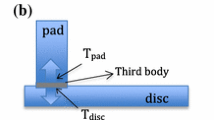The tribological tests are carried out to assess the effect of pin diameters on wear characteristics via changing contact stresses and sliding speeds to provide support for choosing friction pair sizes. The friction couple is set as CuZn pins for medium carbon steel (No. 1045 steel) rings. The differential wear rate and its calculation formula are defined to express the line wear rate or the wear resistance of unit cross-section area. The effect of the pin end surface diameter on differential wear rate and its scale/increased multiplier are investigated. When the product (P × V = 0.095) is kept constant, the abrasion loss for the specimens of a small diameter (d1 = 0.6 mm) is lesser than that of the specimens of a large diameter (d2 = 4.0 mm). As compared to the sliding speed, the change in contact stresses exerts a greater influence on the wear behavior, especially for small-diameter specimens. The differential wear rate of small-diameter specimens is always higher than that of the specimens of a large diameter. The scale multiplier of the differential wear rate is always larger than that of the contact pressure stress, especially for small-diameter specimens.






Similar content being viewed by others
References
Z. R. Zhou and L. M. Qian, “Tribological size effect and related problems,” Chin. J. Mech. Eng., 39, 22–26 (2003).
Y. H. Wei and X. L. Wang, “Present status and prospects of the research on dry friction of metallic material under size effect,” Machinery, 54, No. 9, 1–4 (2016).
M. Reguzzoni and M. C. Righi, “Size dependence of static friction between solid clusters and substrates,” Phys. Rev. B, 85, No. 20, 76–83 (2012).
M. Paggi and A. Carpinteri, “Size-scale effects on the friction coefficient: from weak faults at the planetary scale to super lubricity at the nanoscale,” in: G. Stavroulakis (Ed.), Recent Advances in Contact Mechanics, Part of the Lecture Notes in Applied and Computational Mechanics book series (LNACM, Vol. 56), Springer-Verlag, Berlin–Heidelberg (2013), pp. 67–84.
S. Fouvry and R. Merhej, “Introduction of a power law formulation to quantify the contact size effects on friction and wear responses of dry oscillating sliding contacts: Application to a chromium steel interface,” Wear, 301, Nos. 1–2, 34–46 (2013).
R. Kampmann, M. Roddenberry, and W. V. Ping, “Contribution of specimen surface friction to size effect and rupture behavior of concrete,” ACI Mater. J., 110, No. 2, 169–176 (2013).
K. G. Holmberg, “Tribology in reliability engineering,” in: The Second World Tribology Congress (Sept. 3–7, 2001, Vienna, Austria), pp. 13–20.
M. Scherge, “Scale dependence of friction,” in: The Second World Tribology Congress (Sept. 3–7, 2001, Vienna, Austria), pp. 31–38.
H. C. Kou, Y. Z. Zhang, B. L. Shen, et al., “Influence of counterpair volume ratio on dry tribological properties of cast iron,” J. Iron. Steel. Res. Int., 12, No. 3, 59–62 (2000).
B. Song and D. W. Zuo, “Effects of joining parameters and tool geometry on properties of friction stir welding joint of 2024 aluminum alloy and az31 magnesium alloy,” Mater. Rev., 30, No. 10, 134–138 (2016).
J. Chen, X. R. Lv, and S. J. Wang, “Effect of sand size on tribological behavior of nitrile rubber in crude oil medium,” Lubr. Eng., 41, No. 3, 71–75 (2016).
W. Zhu, X. F. Wang, X. R. Wang, and Y. Fu, “Research on the friction and wear property of different geometrical size fiber reinforced polymer-based composite,” New Chem. Mater., 45, No. 5, 179–181 (2017).
J. Chen, H. Fan, W. Zhang, and N. Chang, “Effect of abrasive size on friction and wear characteristics of sealed rubber,” Tech. Innov. Appl., No. 20, 64–64 (2017).
H. Zhu, Y. Zhao, Z. Guo, and S. P. Cui, “Influence of mixing head size on temperature field and residual stress field of friction stir welded joint of 7075 aluminum alloy,” Weld. Tech., 45, No. 5, 59–63 (2016).
A. M. Orlova, “Effect of geometrical dimensions of friction wedges on performance of freight car bogies,” Fore. Rol. Stoc., 48, No. 5, 20–23 (2011).
J. N. Ding, Y. G. Meng, and S. Z. Wen, “Size effect on the mechanical properties and reliability analysis of micro-fabricated polysilicon thin film,” in: IEEE 39th Annual International Reliability Physics Symposium (Orlando, USA, 2001), pp. 106–111.
Y. H. Wei, Y. Z. Zhang, and Y. Chen, “Dry-sliding tribological characteristics of CuZn self-matched pairs under interfering of magnetic field,” J. Mater. Eng., No. 8, 23–27 (2013).
Acknowledgments
The project is supported by the National Natural Science Foundation of China (51641509), the Foundation for University Cadre Teacher of Henan Province (2017GGJS111) and the Science and Technology Foundation of Henan (162102210086, 162102210243).
Author information
Authors and Affiliations
Corresponding author
Additional information
Translated from Problemy Prochnosti, No. 1, pp. 80 – 86, January – February, 2019.
Rights and permissions
About this article
Cite this article
Wei, Y.H., Wang, X.L., Liu, Y.P. et al. Effect of Pin Diameters on the Wear Characteristics of Friction Pairs. Strength Mater 51, 69–75 (2019). https://doi.org/10.1007/s11223-019-00051-2
Received:
Published:
Issue Date:
DOI: https://doi.org/10.1007/s11223-019-00051-2




